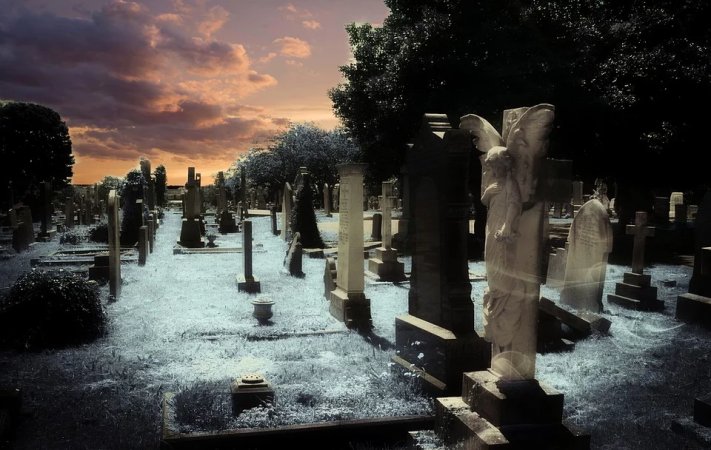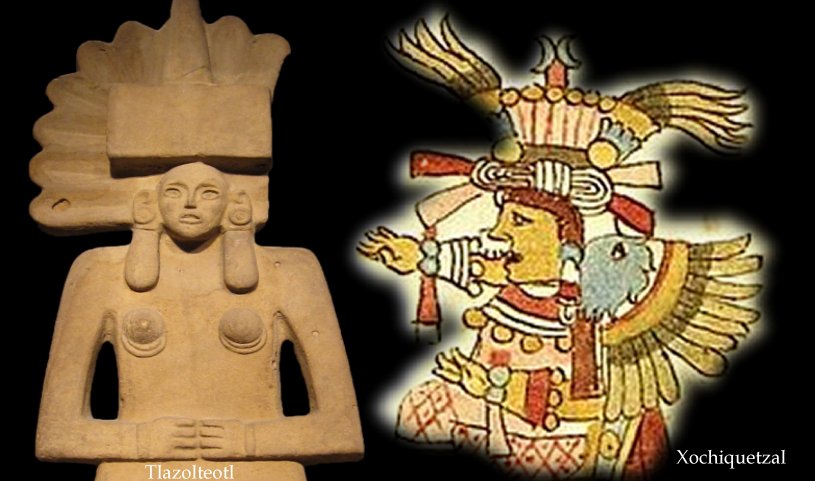Who Were The Sin Eaters?
Conny Waters - AncientPages.com - Not so long ago, a person could get employment as a sin eater and make some money in this unusual profession. As the name implies, sin eaters were those who consumed the sins of a deceased person.
Credit: Public Domain
The Aztec religion offered a formal confession in case of sin or some serious crimes. According to tradition, the Aztecs had the possibility to confess their sins in front of their goddess Tlazolteotl.
The Aztec confession was an important ceremony that usually occurred during the Ochpaniztli Festival.
“After confessing, the person – dressed only in a paper skirt decorated with designs related to goddess Tlazolteotl - had to fast, and then go at night to one of the shrines built for women who died during childbirth. He had to leave its skirt behind, at the shrine - a symbol that they had left behind their sins.” 1
In European countries, the sin-eating ritual was much different. In most cases, a person had to eat something to swallow the deceased's sins.
There are several accounts of sin eaters in Wales. One of the earliest of these stories can be found in The Remaines of Gentilisme and Judaisme, a work of John Aubrey.
A letter from February 1, 1714, relates how sin eating was performed in Wales.
“Within the memory of our Fathers, in Shropshire, in those villages adjoying to Wales, when a person dyed, there was notice given to an old Sire, (for so they called him), who presently repaired to the place where the deceased lay, and stood before the door of the house, when some of the Family came out and furnished him with a Cricket, on which he sat down facing the door. Then they gave him a Groat, which he put in his pocket; a Crust of bread, which he eat; and a full bowle of Ale, which he drank off at a draught. After this, he got up from the Cricket and pronounced, with a composed gesture, the ease and rest of the Soul departed, for which he would pawn his own Soul. “ 2
In many European countries, it was also common to hire poor people to perform funeral services. Their job was to take upon themselves all the sins of the deceased person, which gave many poor people a chance to earn some money.
“The practice of sin-eating began during the Middle Ages and survived into the 19th century in some European countries. At one time it was also practiced by people living in the Appalachian region of the United States.
In many towns the same man was nearly always hired to serve as the sin-eater. This man often became a social outcast because other people believed that all the sins he'd absorbed must have turned him into a vile evil person.
Usually, only a very poor man was willing to play this role. Some of these men learned to recite special prayers or incantations over the bread after they arrived, claiming that this was necessary for the sins to be transferred from the dead body to the bread. They thought that this pretense would increase their chances of being hired when the next death occurred.
When a member of a very poor family died, the survivors often couldn't afford to pay the fee of a sin-eater. In this case, they would sometimes lay a piece of bread on the dead body, say some prayers over it, then carry the bread into the street and give it to a beggar without telling him that it had been on top of a corpse. By using this trick, they could get the sins removed from the body of their loved one for free.“3
One can conclude that how this curious ritual was performed varied between countries and cultures. The practice of eating sins was universal and was encountered among many ancient civilizations.
Updated on April 19, 2024
Written by Conny Waters – AncientPages.com Staff Writer
Copyright © AncientPages.com All rights reserved. This material may not be published, broadcast, rewritten or redistributed in whole or part without the express written permission of AncientPages.com
Expand for references- Sutherland - What Was An Aztec Confession? AncientPages.com
- Hartland, E. Sidney. "The Sin-Eater." Folklore3, no. 2 (1892): 145-57. Accessed January 21, 2020.
- Barry Wilson – Weird Beliefs
More From Ancient Pages
-
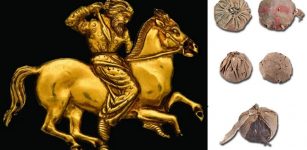 Eurasian Horse Riders Played Ball Games 3,000 Years Ago – Leather Balls Found In Graves Reveal
Archaeology | Oct 12, 2020
Eurasian Horse Riders Played Ball Games 3,000 Years Ago – Leather Balls Found In Graves Reveal
Archaeology | Oct 12, 2020 -
 Why Was Louis XIV Called The Sun King?
Ancient History Facts | Jul 11, 2019
Why Was Louis XIV Called The Sun King?
Ancient History Facts | Jul 11, 2019 -
 Fossilized Skulls Reveal Relatives Of Today’s Rhinos Had No Horn And Died Out 5 Million Years Ago
Fossils | Nov 2, 2023
Fossilized Skulls Reveal Relatives Of Today’s Rhinos Had No Horn And Died Out 5 Million Years Ago
Fossils | Nov 2, 2023 -
 ‘Tonina Chiapas’ Mayan Pyramid In Southern Mexico Is Among The Largest Yet Found
Civilizations | Oct 29, 2018
‘Tonina Chiapas’ Mayan Pyramid In Southern Mexico Is Among The Largest Yet Found
Civilizations | Oct 29, 2018 -
 Satellites Discover Over 160 Hidden Ancient Mounds In North America
Archaeology | Aug 2, 2018
Satellites Discover Over 160 Hidden Ancient Mounds In North America
Archaeology | Aug 2, 2018 -
 Mysterious Cucuteni-Tyrpillian Culture Burned Their Settlements For Unknown Reasons
Civilizations | Feb 12, 2021
Mysterious Cucuteni-Tyrpillian Culture Burned Their Settlements For Unknown Reasons
Civilizations | Feb 12, 2021 -
 Frightening Edinburgh Vaults: The Spooky Underground City Of The Dead
Featured Stories | Jun 4, 2016
Frightening Edinburgh Vaults: The Spooky Underground City Of The Dead
Featured Stories | Jun 4, 2016 -
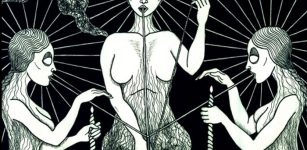 Goddesses Of Fate And Destiny In Greek, Roman And Slavic Mythologies
Featured Stories | Sep 28, 2017
Goddesses Of Fate And Destiny In Greek, Roman And Slavic Mythologies
Featured Stories | Sep 28, 2017 -
 Archaeologists Have Discovered A Mummy Wrapped In Gold – Here’s What It Tells Us About Ancient Egyptian Beliefs
Featured Stories | Feb 7, 2023
Archaeologists Have Discovered A Mummy Wrapped In Gold – Here’s What It Tells Us About Ancient Egyptian Beliefs
Featured Stories | Feb 7, 2023 -
 Extraordinary Gold Pendant With Cross Re-Writes Anglo-Saxon History – It’s One Of The Oldest Symbols Of Christianity Ever Found In East Anglia
Archaeology | Dec 11, 2017
Extraordinary Gold Pendant With Cross Re-Writes Anglo-Saxon History – It’s One Of The Oldest Symbols Of Christianity Ever Found In East Anglia
Archaeology | Dec 11, 2017 -
 King Ferdinand’s Secret Code Deciphered After 500 Years
Archaeology | Feb 14, 2018
King Ferdinand’s Secret Code Deciphered After 500 Years
Archaeology | Feb 14, 2018 -
 Norse Legend Of Hero Sigmund And The Magical Sword In The Branstock Tree
Featured Stories | Jun 25, 2016
Norse Legend Of Hero Sigmund And The Magical Sword In The Branstock Tree
Featured Stories | Jun 25, 2016 -
 Stone Homes Of Europe’s First Megalithic Builders Discovered
Archaeology | Feb 22, 2023
Stone Homes Of Europe’s First Megalithic Builders Discovered
Archaeology | Feb 22, 2023 -
 Why Was The Dmanisis Gora Fortress Community So Resilient In The Transition From The Bronze To Iron Age
Archaeology | Jun 5, 2023
Why Was The Dmanisis Gora Fortress Community So Resilient In The Transition From The Bronze To Iron Age
Archaeology | Jun 5, 2023 -
 Huge Defensive Wall Excavated At Tel Erani, Israel Is More Than 5,300 Years Old
Archaeology | Sep 12, 2019
Huge Defensive Wall Excavated At Tel Erani, Israel Is More Than 5,300 Years Old
Archaeology | Sep 12, 2019 -
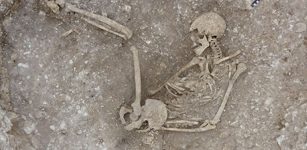 Unusual Iron Age Cemetery Discovered In Dorset, UK
Archaeology | Jul 11, 2022
Unusual Iron Age Cemetery Discovered In Dorset, UK
Archaeology | Jul 11, 2022 -
 On This Day In History: Christiaan Huygens Discovers Saturn’s Largest Moon Titan – On Mar 25, 1655
News | Mar 25, 2017
On This Day In History: Christiaan Huygens Discovers Saturn’s Largest Moon Titan – On Mar 25, 1655
News | Mar 25, 2017 -
 Tricksters: Mischievous Troublemakers Making Attempts To Help And Hinder In Mythologies Of Ancient Cultures
Featured Stories | Oct 28, 2019
Tricksters: Mischievous Troublemakers Making Attempts To Help And Hinder In Mythologies Of Ancient Cultures
Featured Stories | Oct 28, 2019 -
 Archaeologists Uncover Secrets Of ‘Vallø Borgring’ Viking Age Circular Fortress
Archaeology | Oct 11, 2015
Archaeologists Uncover Secrets Of ‘Vallø Borgring’ Viking Age Circular Fortress
Archaeology | Oct 11, 2015 -
 Excavations In Keezhadi, Tamil Nadu, India Shed Light On Life During Sangam Age
Artifacts | Aug 24, 2015
Excavations In Keezhadi, Tamil Nadu, India Shed Light On Life During Sangam Age
Artifacts | Aug 24, 2015

